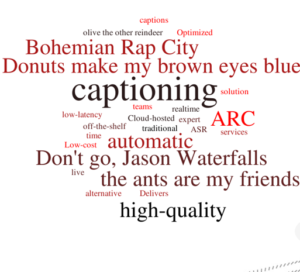By Calum Davidson, Strategic Product Manager @ Red Bee Media
It was recently announced that Red Bee is providing captions for the DPP’s online events, and in the press release the DPP expressed the importance of providing accessible content to its community.
Enriching content in this and other ways was in fact also the main topic when I took part in the DPP innovation week last month, where I gave a three-minute pitch in the Content Enrichment slot – novel ways to get more from your video.
I was watching the other pitches like a hawk to see what might happen should anyone go over time – no-one did, disappointingly. Professionals all round.
Having helped organize captioning provision many times in the past, I’ve now had the opportunity to experience an event like this from the other end. After years of worrying about producing accurate captions, I’ve now had my own words transformed to text on a screen. I apologize to those trying to deal with my ridiculous word rate – I blame the clock sharing my screen, with its faintly alarming three-minute countdown.


 Supply
Supply 
